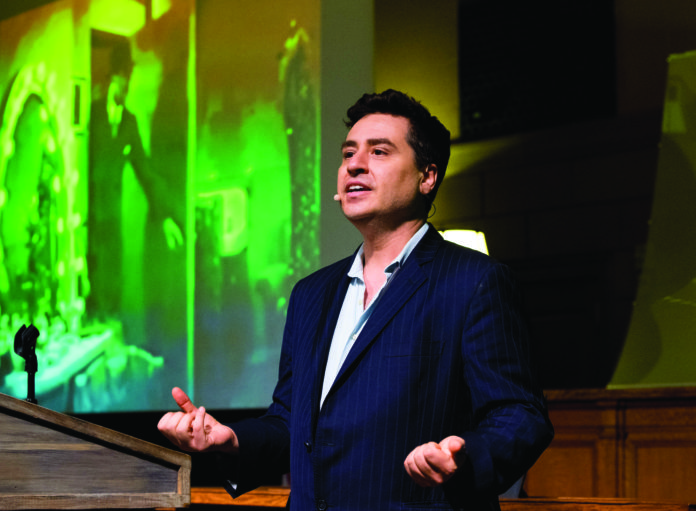In the historic courtroom of the Mob Museum in downtown Las Vegas, author Alex Hortis showed photographs of patrons at early 20th century gay and lesbian bars in New York City, along with advertisements and illustrations for drag shows, a picture of a 1920s drag ball and two mug shots of a Cosa Nostra crime boss.
It’s an unusual pairing that has gotten little attention over the years, but the mob’s involvement with the LGBTQIA+ community is something Hortis has been discussing for some time and has included in his 2014 book, “The Mob and the City: the Hidden History of How the Mafia Captured New York.”
And though his talk, presented by The Center, is titled “Stonewall and the Mob: The 50th Anniversary of the Gay Rights Movement,” Hortis is actually filling in the rest of the decades long story first — an odd entwinement of dependency and profiteering between two divergent groups — that dates back to the turn of the century with the Paresis Hall, a New York brothel and gay bar in the1890s.
So much has been reported about the mob and presented in movies and literature, but its interaction with the LGBTQIA+ community has largely been absent from the narrative, Hortis said, adding that neither group was particularly proud of claiming it.
“It wasn’t covered by the mainstream media. It wasn’t told by historians. It wasn’t even covered by organized crime books,” he said. “It was all kind of a hidden history that was in the closet.”
There is, however, a three-minute clip of a 1933 pre-code Hollywood film, “Arizona to Broadway” that Hortis played for the audience. In the movie, the mafia is a coercing an openly gay performer to sing in drag for their big production show as part of the larger plot to feature the city’s top performers. When the character, played by Gene Malin, appears dressed as Mae West before taking the stage, the gangster, having looked at her painted and jeweled said, “Well kid, you ain’t my type, but you’re all right.”
To that, she responds flirtatiously: “Well, you could be had!” before bursting into “Frankie and Johnny” onstage.
And that would be the last movie by America’s first known drag queen on the silver screen. Malin (who helped launch the Panzy Craze in New York speakeasies) died that same year in a car accident.
Prohibition also ended that year, bringing new liquor laws that banned homosexuals from alcohol establishments, thus ending America’s brief acceptance of celebrated gays, lesbians and drag queens in New York nightlife.
Liquor laws made it illegal for homosexuals or cross-dressers to even be served in bars. Meanwhile, enforcement in Hollywood through the Hays Code was about to ban homosexuality (along with infidelity, drug use and prostitution) from its films. Even famed bisexual actress Marlene Dietrich signed a contract in 1933 with Paramount agreeing to not perform again in men’s clothes. Homosexuality in America would disappear from public view. “
Alcohol prohibition ends and what amounts to what I call, ‘gay prohibition’ begins,” said Hortis, who told the audience that it was better to be gay in the 1920s than in the 1950s and 1960s. It wasn’t like today, but it was fairly tolerated in certain venues. A lot of people often forget that because the closet was so long and painful for people.”
The mafia continued running underground clubs serving the LGBTQIA+ community by paying off the police. It wasn’t until after the Stonewall Riots of 1969 that it became widely known. The owner of the Stonewall Inn, Matthew “Matty the Horse” Ianiello, a captain in the Genovese crime family, also owned other gay bars and porn shops.
“Organized crime provided places where gay, lesbian and transgendered people could be themselves in a society that was extremely hostile and dangerous otherwise,” Hortis said. “It was not the perfect home, but it was a home.”
The mob establishments were run-down spaces that often had poor plumbing, served high-priced bootlegged or cheap watered-down alcohol that was undrinkable. Between the mandatory drink minimum and cigarette vending machine sales, they raked in huge profits from the vulnerable population. The police held “show raids” to appease complaining neighbors, tipping off the mob owners beforehand.
The Stonewall Inn was such a dump that it had no running water at the front bar and water on the floor.
Glasses were simply rinsed out, rather than washed with clean soap and water. The bathrooms were horrid.
The arrangement between the mafia and the police was so oppressive — resulting in patrons hauled off in police wagons, or even worse, having their names printed in the newspaper — that the Stonewall Riots were more about the LGBTQIA+ anger at the mafia, rather than anger at the police, Hortis said. Pamphlets urging New Yorkers to “get the Mafia and the cops out of gay bars” were distributed in the wake of the riots, and the Stonewall Inn was marked with white spray paint that read, “Gay prohibition corrupts cop$, feed$ mafia.”
The community was rallying and the gay pride movement would begin.
Ironically, in Las Vegas, a city with a lot of gay men and women and a historically heavy mob presence, the story was different, Hortis said, ending his talk by tying in Las Vegas. The mob was focused on gaming and simply wanted the gay bars off the Strip, he added. Not only that, they paid a flamboyantly gay piano player from the Midwest as much as $400,000 a week to perform for its audiences in his jewels and capes.



























